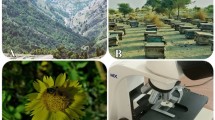Summary
To know basic information about the stingless bee,Trigona minangkabau, and the European honey bee,Apis mellifera, as pollinator of strawberry, we set three greenhouse areas: the honey bee introduced area, the stingless bee introduced area and the control area. Foraging and pollination efficiencies of the two bee species were studied comparatively.
During the experimental period (10 days), the stingless bee foraged well and the nest weight did not change, though the honey bee often foraged inefficiently and the nest weight decreased by 2 kg. The average nectar volume of a flower was lower in the honey bee area (0.02 μl) and nearly the same in the other two areas (0.1 μl).
We make a numerical model to describe pollination and fertilization process. This model shows that one visit of the honey bee pollinated 11% of achenes and one visit of the stingless bee did 4.7% on average and that 11 visits of the honey bee or 30 visits of the stingless bee are required per flower to attain normal berry (fertilization rate, 87%). In this study, the rate of deformed berries in the stingless bee area (73%) was lower than that of the control area (90%), but higher than that of the honey bee area (51%). From our numerical model, we conclude the stingless bee could pollinate strawberry as well as the honey bee if we introduced 1.8 times of bees used in this experiment.
Similar content being viewed by others
References
Abe, Y. (1971)Strawberry Cultivation Using Honey Bee. Non-bun-kyo, Tokyo, Japan. (in Japanese)
Chagnon, M., J. Gingras and D. de Oliverira (1989) Effect of honey bee (Hymenoptera: Apidae) visits on the pollination rate of strawberries.J. Econ. Entomol. 82: 1350–1353.
Free, J. B. (1968) Pollination of strawberry by honey bee.J. Hortic. Sci. 43: 107–111.
Fujii, K., C. S. Holling and P. M. Mace (1986) A simple generalized model of attack of predators and parasites.Ecol. Res. 1: 141–156.
Gause, G. F. (1934)The Struggle for Existence. Williams and Wilkins, Baltimore.
Hartley, H. O. (1961) The modified Gauss-Newton method for the fitting of non-linear regression functions by least squares.Technometrics 3: 269–280.
Inoue, T., S. F. Sakagami, S. Salmah and S. Yamane (1984) The process of colony multiplication in the Sumatran stingless beeTrigona (Tetragonula) laeviceps.Biotropica 16: 100–111.
Inoue, T., S. Salmah, I. Abbas and E. Yusuf (1985) Foraging behavior of individual workers and foraging dynamics of colonies of three Sumatran stingless bees.Res. Popul. Ecol. 27: 373–392.
Katayama, E. (1987) Utilization of honeybees as pollinators for strawberries in plastic greenhouses.Honeybee Science 8: 147–150. (in Japanese)
Maeta, Y. T., T. Tezuka, H. Nadano and K. Suzuki (1992) Utilization of the Brazilian stingless bee,Nannotrigona testaceicornis as a pollinator of strawberries.Honeybee Science 13: 71–78. (in Japanese)
Roubik, D. W. (1989)Ecology and Natural History of Tropical Bees. Cambridge, Univ. Press, New York.
Sakagami, S. F. (1982) Stingless bee. In H. R. Hermann (ed.)Social Insects 3: 361–423. Academic Press, New York.
Sakagami, S. F., T. Inoue, S. Yamane and S. Salmah (1983) Nest architecture and colony composition of the Sumatran stingless beeTrigona (Tetragonula) laeviceps.Kontyû 51: 100–111.
SAS institute inc. (1985)SAS User's Guide: Statitics, Version 5 Edition. Cary, NC, USA.
Schwarz, H. F. (1948) Stingless bees (Meliponidae) of Western Hemisphere.Bull. Am. Mus. Nat. Hist. 90: 1–564.
Seeley, T. D. (1985)Honeybee Ecology, A Study of Adaptation in Social Life. Princeton Univ. Press, Princeton, New Jersey.
Skrebtsova, N. D. (1957) Le role des abeilles dans la pollinisation du fraisier.Pchelovodsvo 34: 34–36.
Visscher, P. K. and T. D. Seeley (1982) Foraging strategy of honeybee colonies in temperate deciduous forest.Ecology 63: 1790–1801.
Author information
Authors and Affiliations
Rights and permissions
About this article
Cite this article
Kakutani, T., Inoue, T., Tezuka, T. et al. Pollination of strawberry by the stingless bee,Trigona minangkabau, and the honey bee,Apis mellifera: An experimental study of fertilization efficiency. Res Popul Ecol 35, 95–111 (1993). https://doi.org/10.1007/BF02515648
Issue Date:
DOI: https://doi.org/10.1007/BF02515648




